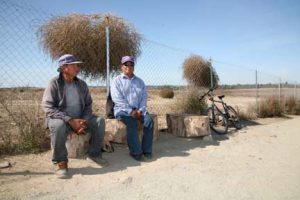
OCEANSIDE
– In Oceanside, Carlsbad, Del Mar and north San Diego County, immigrant day laborers wait by the side of the road, hoping a contractor will stop and offer them work. Alberto Juarez Martinez slings his jacket over his shoulder while he waits. His hands show the effect of a lifetime of manual work, plus arthritis suffered as a child in Zapata, Zacatecas. The hands of Beto, a migrant from Uruachi, Chihuahua, also show the effect of a lifetime of manual work. Juan Castillo, a migrant from Tehuacan, Puebla, waits with his friends in the parking lot of a market they’ve nicknamed La Gallinita, because of the rooster on the roof of the building.
Police in north county towns have now started cruising by day labor sites in plainclothes, pretending to be contractors offering workers jobs, and then citing them and turning them over to immigration agents, even those with green cards. Many community organizations are protesting this practice.
Francisco Villa operates a lunch truck that visits the areas where migrant day laborers live on hillsides and under trees. Villa hands out leaflets advising workers of their rights and letting them know that they can find help from California Rural Legal Assistance. Across the street from Villa’s truck, Zaragosa Brito and Andres Roman Diaz, two migrants from Arcelia, Guerrero, sit next to a fence where workers look for day labor, or get rides to the fields for farm work. The men sleep out in the open in the field behind the fence, and have worked on a local strawberry ranch, Rancho Diablo, for many years.
A few miles away, farm workers harvest marjoram and basil at Herb Thyme Farms in Oceanside. Harvesting marjoram means using a short knife that requires workers to work bent over double. Years of this labor can cause permanent damage to the spine.
One possible future for migrant farm laborers is visible in a crew of workers picking tomatoes on the Camp Pendleton Marine Corps base. These are H2-A guest workers, recruited in Mexico by grower Harry Singh. On the base, the workers are hidden in the rows behind a barbed wire fence, and outside labor organizers or legal advisors can’t gain access. At the end of the day, these guest workers are taken to a labor camp on Singh’s ranch, where access is also restricted in order to keep them isolated from the surrounding community. H2-A guest workers can’t leave their jobs without being deported back to Mexico. They fear that if they protest or even speak with legal aid, they won’t be hired the following season. Singh used to be the only California grower importing H2-A workers, but now there are several. The number is growing.

Photo exhibit by David Bacon titled “Living under the trees,” at the Institute of the Americas, University of California, San Diego in La Jolla, explore the unique challenges facing California’s indigenous Mexican communities, the consequences of economic displacement from Mexico, the challenges these communities face in California as well as their rich culture and community spirit that sustains them.
The exhibit in conjunction with the California Rural legal Assistance and Frente Indígena de Organizaciones Binacionales (Binational Indigenous People Organization Front) shows Bacon’s ongoing work with immigrant communities across California.
“In my view the problem is not immigration but inequality, a situation we have been fighting against since the birth of this nation” says Bacon, “it is inequality what fueled civil rights and it is what is fueling current debate, because it is obvious we need to reform our laws and stop the institutionalization of racial discrimination, because of who is coming and why”.
Living Under The Trees presents a thoughtful series of photographs and personal stories that explores the unique challenges indigenous communities face, while also celebrating the culture and community spirit that sustains them. This exhibition helps to highlight the ongoing need for legal support and education to protect the rights of these communities. The exhibition will be on display at San Diego’s Institute of The Americas through November 27, 2009. Viewing is from 10a.m.-5p.m. and free to the public. For information call (858) 453-5560.